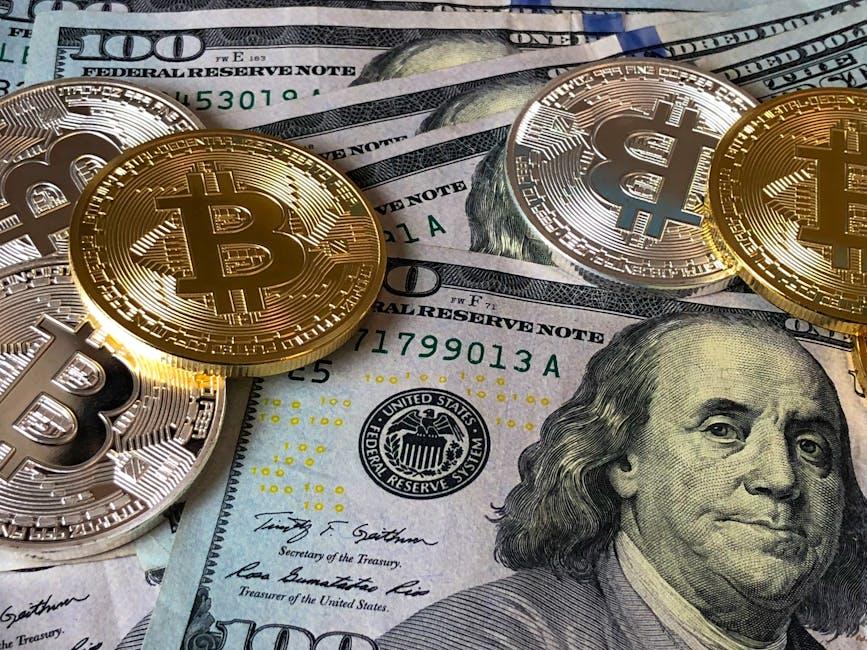In a monetary panorama regularly reshaped by innovation and altering perceptions, Bitcoin’s standing as “digital gold” has lengthy been a compelling narrative. Initially celebrated for its potential as a hedge towards conventional market volatility and inflation, Bitcoin captured the creativeness of buyers looking for a brand new type of worth storage. However as we transfer deeper into 2025, with evolving laws, market dynamics, and the doorway of recent digital belongings, the query arises: does Bitcoin nonetheless maintain its crown as the last word digital secure haven? This text delves into the prevailing sentiment amongst institutional buyers, exploring whether or not Bitcoin stays the trusted retailer of worth it as soon as was, or if its shine is starting to fade within the eyes of the monetary elite.
Rethinking Bitcoin’s Function within the Trendy Digital Economic system
Within the ever-evolving panorama of digital belongings, Bitcoin’s fame as “digital gold” faces rising scrutiny from institutional buyers. Whereas its foundational attraction as a decentralized retailer of worth nonetheless holds, the narrative surrounding Bitcoin is shifting to accommodate a broader and extra complicated position inside the digital economic system. Establishments at the moment are weighing its utility not simply towards conventional hedges like gold, but additionally alongside rising digital improvements similar to decentralized finance (DeFi) and Central Financial institution Digital Currencies (CBDCs). This re-evaluation displays a nuanced understanding: Bitcoin is not only a static reserve asset however a dynamic monetary instrument with layered implications for portfolio diversification, danger administration, and strategic digital asset allocation.
The impression of this evolving sentiment is twofold. On one hand, there’s a renewed appreciation for Bitcoin’s deflationary design and its potential to safeguard wealth amid inflationary pressures. On the opposite, establishments are more and more attentive to Bitcoin’s integration challenges, together with scalability points and regulatory uncertainties that might have an effect on liquidity and institutional adoption. Consequently, many buyers are adopting a cautious but optimistic stance, treating Bitcoin as a part of a broader digital asset ecosystem fairly than a monolithic answer. This angle encourages incorporation of Bitcoin inside diversified digital methods, acknowledging it as a pioneering asset whose future relevance depends upon its capacity to adapt and coexist with the quickly maturing digital economic system.

Institutional Views Shaping Bitcoin’s Future Worth
Institutional buyers proceed to play a pivotal position in framing the narrative round Bitcoin’s intrinsic and speculative worth. As main monetary entities combine Bitcoin into diversified portfolios, it more and more capabilities as a hedge towards conventional market volatility and inflation—traits that cement its fame as “digital gold.” Nonetheless, this attitude is balanced by a cautious optimism; establishments weigh regulatory uncertainties and technological shifts that might both bolster or problem Bitcoin’s standing. Their evolving methods replicate a mix of belief in Bitcoin’s decentralized resilience and vigilance towards adapting in a fast-changing financial panorama.
Furthermore, the dialogue inside institutional circles highlights a nuanced appreciation of Bitcoin’s twin identification—not solely as a retailer of worth but additionally as an instrument driving innovation in cost techniques and asset tokenization. This duality influences funding approaches, with some gamers emphasizing Bitcoin’s shortage and safety, whereas others concentrate on its potential to reshape monetary ecosystems. The interaction of those views underscores a classy institutional sentiment that may possible information Bitcoin’s worth trajectory amid broader financial and regulatory currents in 2025 and past.

Evaluating Bitcoin and Conventional Protected-Haven Property
Bitcoin continues to intrigue institutional buyers as a contemporary counterpart to historical safe-haven belongings like gold and authorities bonds. Not like conventional belongings, Bitcoin gives unparalleled liquidity and operates on a borderless, decentralized community, making it accessible to a world viewers 24/7. Nonetheless, it stays unstable in comparison with the regular, albeit slower, progress of gold. This volatility is a double-edged sword; whereas it poses danger, it concurrently creates high-reward alternatives that conventional secure havens not often provide. Establishments weigh these elements fastidiously, generally favoring Bitcoin for diversification however typically anchoring vital parts of their portfolios in time-tested belongings throughout turbulent market phases.
However, conventional safe-haven belongings possess longstanding reputations for stability and intrinsic worth, with gold being the archetype for wealth preservation throughout financial downturns. These belongings profit from historic belief, bodily tangibility, and regulatory frameworks which have matured over centuries. Bitcoin’s digital nature challenges these conventions, providing transparency and programmability that gold and bonds lack. Institutional sentiment in 2025 displays a nuanced perspective—whereas Bitcoin will not be but universally accepted as a alternative for bodily secure havens, it more and more performs a complementary position, mixing innovation with the foundational ideas of monetary safety.

Market Volatility and Its Influence on Bitcoin Sentiment
Market volatility stays a defining attribute of Bitcoin, shaping each its notion and utilization amongst institutional buyers. Dramatic value swings can ignite a whirlwind of feelings, swinging sentiment between optimism and warning. Whereas the attract of fast good points attracts opportunistic merchants, sustained volatility prompts seasoned buyers to scrutinize Bitcoin’s stability as a retailer of worth. This delicate stability has carved out a nuanced view: Bitcoin is seen not solely as “digital gold” however as a unstable asset with distinctive hedging potential, able to each disrupting and complementing conventional monetary portfolios.
The interaction between surprising world occasions and Bitcoin’s value motion additionally amplifies sentiment shifts. Buyers typically react swiftly to macroeconomic indicators, regulatory developments, or geopolitical tensions, which might both bolster confidence or gasoline skepticism about its long-term viability. Regardless of these fluctuations, a rising cohort of institutional individuals is enhancing their portfolio methods by integrating superior danger administration methods and embracing Bitcoin’s intrinsic volatility as a calculated side of diversification—acknowledging that within the evolving panorama of 2025, volatility doesn’t essentially undermine Bitcoin’s position however fairly redefines the narrative of its worth proposition.

Regulatory Developments Influencing Institutional Adoption
As regulatory frameworks round cryptocurrencies proceed to evolve, institutional gamers are more and more navigating a posh panorama that concurrently gives readability and challenges. Current shifts towards extra complete guidelines—starting from enhanced anti-money laundering mandates to clearer tax tips—have painted digital belongings in a extra authentic gentle. This regulatory maturation encourages hedge funds, asset managers, and pension funds to issue Bitcoin into their portfolios with higher confidence, seeing it as a compliant and sturdy asset fairly than a speculative gamble. But, the various tempo and nature of regulation throughout jurisdictions imply establishments should stability cross-border compliance dangers with the potential advantages of digital diversification.
Furthermore, the rising dialogue between regulators and business individuals is fostering an atmosphere the place innovation can coexist with oversight. Regulatory sandbox initiatives and clearer definitions of digital asset classifications empower establishments to experiment with Bitcoin-related monetary merchandise with out concern of abrupt crackdowns. This hands-on cooperation is essential, because it helps form insurance policies that shield buyers and preserve market integrity whereas preserving Bitcoin’s distinctive attributes as a retailer of worth. Finally, these developments underline a pivotal shift: establishments are more and more viewing regulatory engagement not as a barrier, however as a basis for constructing lasting belief in Bitcoin’s position inside world finance.

Technological Improvements Enhancing Bitcoin’s Attraction
Developments in blockchain expertise have considerably elevated Bitcoin’s performance past its authentic imaginative and prescient as merely a digital asset. Layer 2 options just like the Lightning Community have revolutionized transaction speeds and prices, making Bitcoin funds extra sensible for on a regular basis use and micropayments. This not solely broadens its attraction but additionally positions Bitcoin as a viable complement to conventional monetary techniques. Moreover, improvements in cryptographic requirements and privateness protocols are enhancing safety and consumer confidence, addressing important considerations about traceability and fungibility.
Concurrently, the mixing of good contract capabilities by means of sidechains and cross-chain interoperability protocols has expanded Bitcoin’s ecosystem, permitting it to interact with decentralized finance (DeFi) purposes and complicated programmable capabilities. These technological refinements foster a extra dynamic and versatile community, attracting institutional gamers who search strong, scalable, and safe digital belongings. Consequently, Bitcoin’s technological evolution reinforces its attraction as each a retailer of worth and a purposeful platform within the trendy monetary panorama.

Diversification Methods Involving Bitcoin in 2025
Establishments more and more view Bitcoin not simply as a speculative asset however as an integral component of diversified portfolios. Its distinctive traits—similar to shortage, decentralized nature, and relative independence from conventional monetary techniques—make it an interesting hedge towards inflation and foreign money debasement. Many asset managers are mixing Bitcoin with conventional holdings like equities and bonds to boost risk-adjusted returns, whereas additionally leveraging its low correlation to different asset lessons to cushion volatility throughout market downturns.
Past direct possession, diversification methods now typically embrace publicity by means of progressive monetary devices and decentralized finance platforms. Institutional buyers are exploring choices similar to Bitcoin-linked derivatives, tokenized belongings, and yield-generating protocols to optimize their risk-reward profiles. This multidimensional method not solely helps handle liquidity and counterparty dangers but additionally opens up new avenues for earnings era, making Bitcoin a dynamic element within the evolving panorama of portfolio development in 2025.

Danger Administration Approaches for Institutional Bitcoin Holdings
Institutional buyers are more and more adopting a layered method to managing danger of their Bitcoin portfolios, mixing time-tested methods with progressive monetary devices. Central to that is diversification, not simply throughout cryptocurrencies but additionally inside Bitcoin publicity itself—using derivatives similar to futures and choices to hedge towards volatility. This strategic balancing act permits establishments to keep up upside potential whereas safeguarding capital by means of measured danger controls and dynamic rebalancing. Moreover, many corporations now incorporate state of affairs planning and stress testing into their frameworks, simulating excessive market actions to arrange for unpredictability inherent in digital asset markets.
Danger administration additionally extends past value fluctuations, encompassing operational and regulatory hurdles that might impression holdings. To mitigate these threats, establishments rely closely on safe custody options, typically partnering with regulated custodians who provide insurance coverage and strong compliance frameworks. Moreover, governance protocols have turn into extra refined, with multi-signature wallets and strict entry controls limiting publicity to inside errors or exterior cyber threats. Collectively, these approaches replicate a maturing ecosystem the place safeguarding Bitcoin is as a lot about prudent operational practices as it’s about navigating market dangers.

Evaluating Bitcoin’s Lengthy-Time period Viability as Digital Gold
Bitcoin’s place as “digital gold” continues to spark debate amongst institutional buyers in 2025, the place its long-term viability is weighed towards each conventional safeguards and rising monetary improvements. Not like bodily gold, Bitcoin gives unparalleled portability and divisibility, coupled with a clear and decentralized ledger. Nonetheless, considerations round regulatory crackdowns, vitality consumption, and value volatility persist. Establishments are more and more assessing whether or not Bitcoin can constantly function a dependable retailer of worth or if it stays extra speculative—a device of hedging and diversification fairly than a pure secure haven.
Institutional sentiment displays a nuanced outlook; whereas some gamers embrace Bitcoin’s shortage and borderless nature, others stay cautious because of macroeconomic uncertainties and evolving authorities insurance policies. The digital asset’s distinctive properties encourage recent views on wealth preservation, but additionally they demand rigorous danger administration methods unusual to conventional belongings like gold. As Bitcoin steadily matures in infrastructure and market depth, its true check as a reliable long-term asset lies in balancing innovation with stability, interesting not simply to early adopters however to a broader cohort of conservative buyers.

Sensible Suggestions for Navigating Bitcoin Investments
When venturing into Bitcoin investments, it is essential to stability enthusiasm with disciplined technique. Buyers ought to prioritize thorough due diligence, specializing in market tendencies and institutional sentiment shifts fairly than chasing short-term good points. Diversifying portfolios to incorporate a mixture of asset lessons may help mitigate the inherent volatility of Bitcoin. Moreover, setting clear entry and exit factors primarily based on reasonable danger assessments permits extra managed publicity. Keep in mind, Bitcoin’s position as “digital gold” stays contested, so staying knowledgeable about regulatory developments and technological developments will present a tactical edge in decision-making.
Danger administration ought to be the cornerstone of any Bitcoin funding method. Using instruments like stop-loss orders can shield towards sudden market downturns, whereas dollar-cost averaging permits accumulation over time with out the stress of timing the market completely. Participating with respected custodians and exchanges fortifies safety, serving to buyers sidestep frequent pitfalls similar to hacking or fraud. Lastly, cultivating persistence and a long-term mindset fosters resilience amidst the market’s fluctuations, reflecting the nuanced actuality that Bitcoin’s worth proposition extends past hypothesis and requires a seasoned perspective to harness successfully.
Q&A
Q&A: Is Bitcoin Nonetheless Digital Gold? Institutional Sentiment in 2025
Q1: What does the time period “digital gold” imply in relation to Bitcoin?
A1: The phrase “digital gold” refers to Bitcoin’s position as a perceived retailer of worth, much like how bodily gold capabilities in conventional finance. It implies that Bitcoin is a scarce digital asset with properties that shield towards inflation and foreign money devaluation, making it a possible secure haven throughout financial uncertainty.
Q2: How has institutional sentiment towards Bitcoin advanced by 2025?
A2: By 2025, institutional sentiment has turn into extra nuanced. Early adopters seen Bitcoin primarily as a speculative funding and a hedge towards inflation. Now, many establishments acknowledge Bitcoin’s utility each as a retailer of worth and as a element inside diversified portfolios, although considerations about regulatory readability and market volatility nonetheless mood enthusiasm.
Q3: Are establishments nonetheless treating Bitcoin as “digital gold” or has their notion shifted?
A3: Establishments proceed to acknowledge Bitcoin’s distinctive traits as “digital gold,” significantly its shortage and decentralization. Nonetheless, they more and more view it as a part of a broader digital asset ecosystem fairly than a standalone secure haven. Some see Bitcoin alongside different cryptoassets that provide different worth propositions, reflecting a extra diversified digital asset technique.
This fall: What elements affect institutional belief in Bitcoin’s position as digital gold?
A4: Key elements embrace macroeconomic tendencies similar to inflation and geopolitical tensions, evolving regulatory frameworks, community safety and adoption metrics, in addition to Bitcoin’s liquidity and correlation with different asset lessons. Institutional buyers fastidiously weigh these components to evaluate Bitcoin’s stability and long-term viability as a retailer of worth.
Q5: How do Bitcoin’s properties evaluate to conventional gold from an institutional perspective?
A5: Bitcoin is commonly praised for its ease of transferability, divisibility, and transparency in comparison with bodily gold. It gives a censorship-resistant and programmable different that fits digital finance. Nonetheless, gold nonetheless holds a long time of established belief, tangibility, and lack of counterparty danger, inflicting a wholesome debate over their roles in numerous portfolios.
Q6: What are the foremost dangers establishments understand when investing in Bitcoin in 2025?
A6: Regulatory uncertainty stays paramount, as numerous jurisdictions proceed to refine crypto insurance policies. Market volatility is a priority, particularly in turbulent financial situations. Safety dangers associated to custody and potential technological vulnerabilities additionally weigh on institutional choices, alongside considerations about scalability and environmental impression.
Q7: Can Bitcoin preserve its “digital gold” standing sooner or later?
A7: Bitcoin’s future as digital gold is contingent on sustained community safety, adoption, and clear regulatory frameworks. Its mounted provide and decentralization assist its store-of-value thesis, however evolving market dynamics and competitors from different digital belongings imply that establishments will proceed to reassess Bitcoin’s relative worth proposition. Staying adaptive will probably be key.
Q8: How has Bitcoin’s position influenced institutional portfolio methods in 2025?
A8: Bitcoin is more and more built-in as a non-correlated asset class to hedge towards conventional monetary dangers. Many establishments allocate a small share of their portfolios to Bitcoin for potential long-term appreciation and diversification. The evolving idea of digital gold influences broader discussions on digital asset publicity and danger administration practices.
This Q&A goals to showcase a balanced view of how establishments interpret Bitcoin as digital gold in 2025, reflecting each optimism and warning because the digital asset panorama matures.
To Conclude
As we navigate the complicated panorama of 2025, the query of whether or not Bitcoin nonetheless holds its place as digital gold invitations no easy reply. Institutional sentiment reveals a mosaic of cautious optimism, strategic recalibration, and enduring intrigue. Whereas Bitcoin’s position as a retailer of worth faces new challenges and evolving narratives, its elementary attract as a pioneer of decentralized finance stays plain. Ultimately, whether or not Bitcoin shines because the digital gold of this period or transforms into one thing totally totally different relies upon as a lot on the unfolding story as on those that select to write down it.



